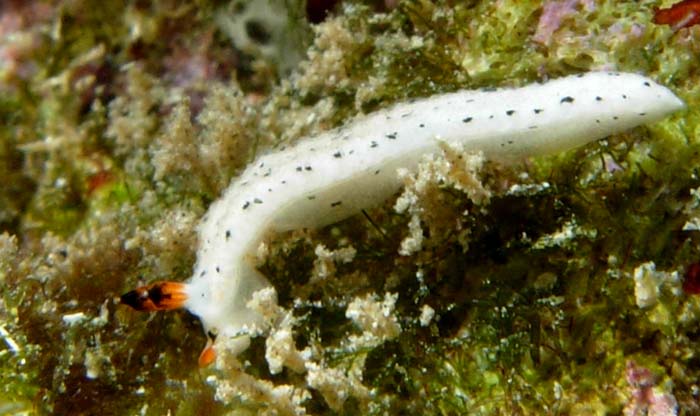This species has been observed on Reunion Island
The ground colour of the dorsum, the oral veil, and the foot is opaque white. There are a few black spots of various sizes scattered in the submarginal area of the notum and a single black spot is also present on the centre of the oral veil The rhinophoral lamellae are orange with a black rhinophoral apex The oral veil has a large orange blotch on its anterior margin. |

|
|
| Showing species characteristics... | Photo Philibert Bidgrain |
|
Remarks :
Identification confirmed by Terry Gosliner and Nathalie Yonow
Synonymous : (according Worms)
- No other name
Material examined by Terry Goliner and Shireen Fahey ( see references/publications).
Holotype : CASIZ 174168, 1 km south of Casuarina, St. Leu, Reunion Island, 1 m depth, collected 21 April 1989 by T. M. Gosliner
Paratypes : CASIZ 174169, eight specimens, two dissected, 1 km south of Casuarina, St. Leu, Reunion Island, 1 m depth, collected 21 April 1989 by T. M. Gosliner.
Bibliographic data :
The body shape of the living animal is short and triangular, flattened, and narrows at the posterior end.
The foot projects only slightly beyond the distinct mantle margin.
The notum is granular and lacks any traces of distinct ridges.
The oral veil extends forward and has pointed corners.
The widely spaced rhinophores are behind the oral veil. They have a series of longitudinal lamellae (rhinophores lamellae are vertical in this family and not horizontal as in the dorids) on the rounded club. The stalk does not narrow noticeably.
The genital opening is on the right side of the body, near the anterior quarter of the body.
The anus is situated approximately one - third of the way to the posterior end of the body.
Between the rhinophores the mantle is continuous with the head, unlike Armina which has a ridge and a groove here
The spawn is white.
Dermatobranchus piperoides is most similar to D. kokonas. These two species have a uniformly white body colour. But D. piperoides also has black spots on the body and black apices on the orange rhinophores, whereas D. kokonas has brown rhinophores. The oral veil of D. kokonas has a fine orange marginal line whereas in D. piperoides there is an orange spot over much of the anterior portion of the veil.
Etymology : The specific name piperoides is a noun in apposition and comes from the Latin, Piper, the genus of black pepper, owing to the resemblance of the black markings on the notum of this species to ground pepper.
References :
Publications :
Gosliner T.M. & Fahey S.J. (2011) Previously undocumented diversity and abundance of cryptic species: a phylogenetic analysis of Indo-Pacific Arminidae Rafinesque, 1814 (Mollusca: Nudibranchia) with descriptions of 20 new species of Dermatobranchus . Zoological Journal of the Linnean Society 161: 245–356.
Other photos of Dermatobranchus piperoides :
 |
Philibert Bidgrain Reunion, Etang salé lagoon, less 1 m, 24 February 2011, size : 6-8 mm The rhinophoral lamellae are orange (a) with a black rhinophoral apex (b) The oral veil has a large orange blotch (c) on its anterior margin. |
Philibert Bidgrain Reunion, Etang salé lagoon, less 1 m, 24 February 2011, size : 6-8 mm
The spawn is white |
 |
 |
 |
 |
Christophe Cadet Reunion, Etang salé lagoon, less 1 m, 23 January 2011, size : 7 mm |
More photos from Indian Ocean
Reunion, when a large seaslug crawl on a small one, at Etang salé, by Jean-Marie Gradot